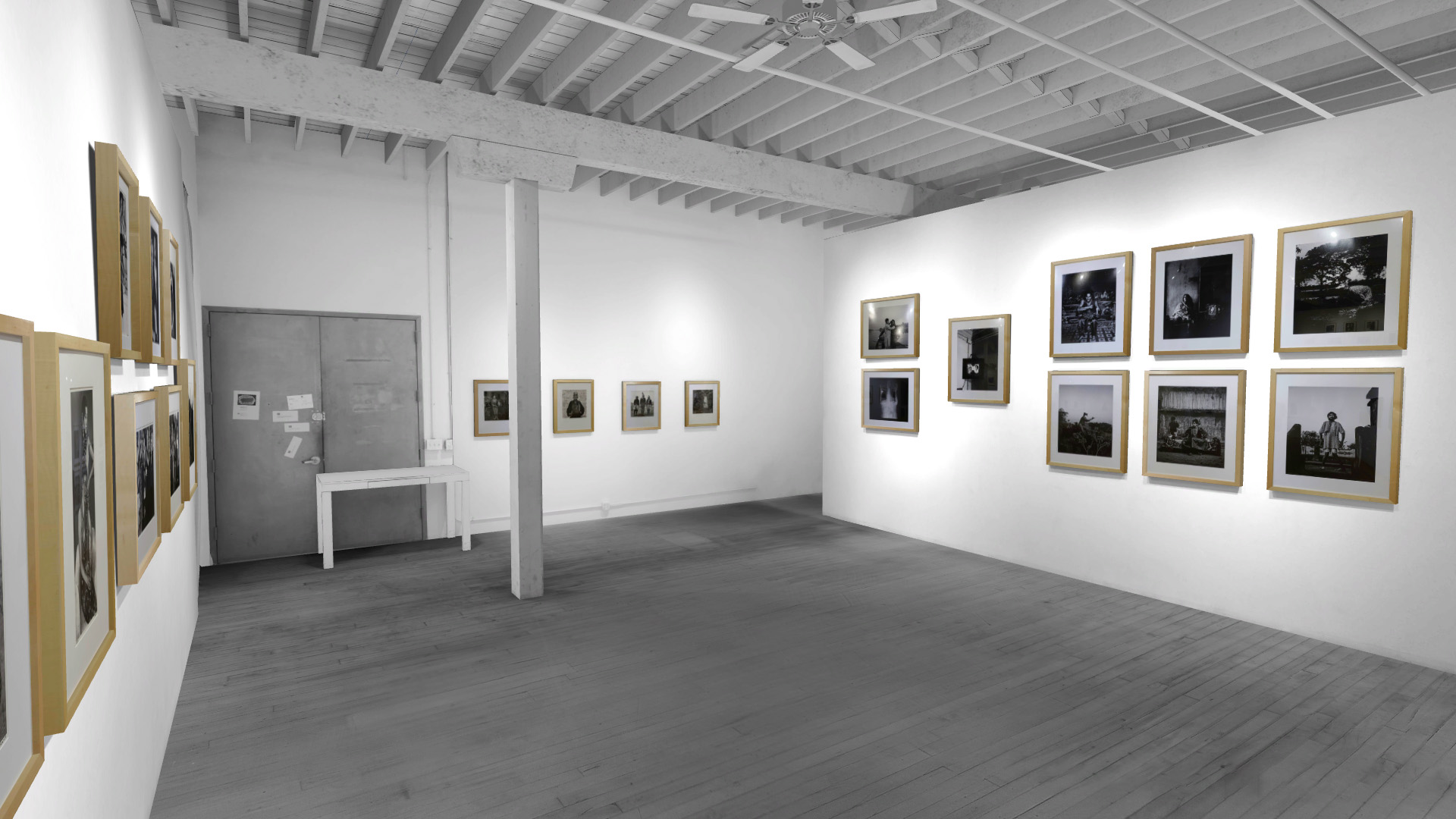

Vivan Sundaram’s Re-take of Amrita is a groundbreaking body... more >> sepiaEYE is pleased to present FACE OFF, a show that explores confrontational and performative portraiture by seven artists working in installation, video, and photography. The exhibition features the work of Vivan Sundaram, Joaquin Trujillo, Pamela Singh, Angelika Sher, Nandita Raman, Soumya Sankar Bose, Serena Chopra and surprises from the private collection of Nigel Maister.
Vivan Sundaram’s Re-take of Amrita is a groundbreaking body of work completed in 2005 which combines photography, painting, family history, and autobiography into multi-faceted contemporary fictions. This series of photomontages utilizes images from his family archive, including photographs taken by his grandfather Umrao Singh Sher-Gil (1870-1954). The primary protagonist of the series is his aunt, the painter Amrita Sher-Gil (1913-1941).
Through the use of digital composition, Vivan Sundaram explores their interactions and creates moments lost in time. Amrita Sher-Gil, a pioneer of figurative modernist painting in India, appears throughout the images, as do her paintings, her Hungarian mother Marie Antoinette, and the photographs and self portraits by Umrao Singh Sher-Gil. Adding to the dreamlike state is Sundaram’s deployment of reassembled staging, mirrors, and multiple reflections.
Joaquin Trujillo shares his project Mal De Ojo in a site-specific installation at the gallery. His series explores the superstition of the “evil eye” that he was believed to be a victim of during his childhood in Latin America owing to his contraction of scarlet fever and subsequent permanent eye damage. The installation at sepiaEYE focuses on the the fetishistic portrayals of the artist’s own physical and psychological trauma with tabletop arrangements of Mexican folk remedies and personal amulets and totems. The scenes deal with the psychosocial aspects of isolation and our inherent need for protectionand self preservation.
Pamela Singh’s photographs form an extended, entrancing journal akin to a waking dream, a search for affirmation of self within our perceived world. In the mid-90s, Singh affixed a rear-view mirror to her camera so that she could capture herself and her surroundings within the frame. Prior to “selfie” culture, she spent her days wandering through the maze of the city, inserting herself within the daily life of the townspeople. A large body of work from this period is printed as black-and-white, gelatin silver prints. A recent exploration of this process, Treasure Maps, photographed in the mid-90s but painted in 2014-15, features a subtle layering of paint and a muted palette. Utilizing the traditional painting techniques of local miniature painters, Singh’s photographs sprout magical enhancements, religious iconography, and colorful details. What were once photographs are now bejeweled narratives of her enchanted world.
Serena Chopra’s photographs offer insight into the communities of her sitters. Drawn from two bodies of work, Bhutan: A Certain Modernity and Majnu ka Tilla Diaries, Chopra informs her photographs with extensive personal interviews and years of repeated visits. The high contrast, formally composed black-and-white images combine portraiture, revealing interiors, and mystifying exteriors to tell intimate stories of the residents. With Majnu Ka Tilla Diaries, Chopra continues he
analytical distance, mirroring her earlier series on Bhutan that spanned over twelve years of work.
Nandita Raman’s body of work When Mountains Rise and Fall Like Waves includes a striking photograph of her mother. Raman speaks of the challenging process of making a portrait of her mother saying, “At the time of photographing my mother, we were going through a particularly difficult time in our relationship. I had married my long time partner (another woman) and returned to see my parents. My mother felt that I betrayed the purity of marriage. Our time together was filled with silence. To sit her down for a portrait and look at her through the ground glass of the glossy cherry wood camera was a setting where she was aware of my single-minded attention towards her. I too stared at her inverted eyes looking straight into the glass but without direct engagement. The camera became a mediator. And the lack of confrontation allowed for a different ‘looking’ one that was more considerate. When the image was processed, incidentally it was the eyes that were obliterated.”
Soumya Sankar Bose’s series Let’s Sing an Old Song presents performative and intimate portraits of the artists of the Jatra, a dying folk theater form based in united Bengal (Bangladesh and West Bengal) dating back to the 16th century. The plays, known as Jatra pala, employ dialogue, monologue, and music to explore Indian mythology, historical events, and social issues. In the wake of the partition of South Asia in 1947, the Jatra tradition saw omissions of Hindu and Muslim topics in India and Pakistan respectively and the community continued to fade with the advent of television, travelling cinemas, and modern media. Let’s Sing an Old Song shares compelling imagery from Bose’s years long documentation of those still involved in the Jatra after his own uncle, once involved in the artform, decided to leave this folk practice because of the lack of financial stability. For Bose, “work is based mainly on the Jatra artists, characters played by them and the psychology that drives them to be a part of this folk cult form.” The project is made possible by a grant awarded by the India Foundation for the Arts. A limited edition postcard collection of the project will also be available at the gallery.
Angelika Sher’s images draw the viewer into a spellbound theatre of inner narratives and overlapping cultural memories, revealing a hypnotic yet profoundly dislocated interior universe. A sense of loss and disquieting beauty—restless, fugitive, and saturated with color—permeates these images. Supplied by her family and immediate environment, the raw material of Sher’s work is the play of memory within memory, of boundaries that elude both explanation and definition, and the fragility and loneliness of childhood.
Nigel Maister is an artist and collector of vernacular photography. The 35 portraits displayed in FACE OFF from the collection of Nigel Maister/foundphotographs.com range from tin-types and handpainted photographs to Polaroids and gelatin silver prints taken over the last 100 years. This installation is mounted in the Director’s office.
ABOUT sepiaEYE
sepiaEYE is dedicated to showing a spectrum of modern and contemporary photography and video work from Asia. Established in September 2009 by Esa Epstein, sepiaEYE will continue to foster artist development through exhibitions, publications, trade fairs, and festivals. We are honored to represent the Estates of Raghubir Singh and Bhupendra Karia. sepiaEYE is interested in the rediscovery of lesser known artists and significant periods within the history of photography and in the support of emerging artists. During her tenure as the Executive Director and Curator of SEPIA International and The Alkazi Collection (1995-2009), Esa Epstein has published eight titles on modern and contemporary photography including: Atul Bhalla: Yamuna Walk (sepiaEYE & UW Press, 2011), Jungjin Lee: Wind, essays by Eugenia Parry and Vicki Goldberg (Aperture/SEPIA, 2009); Ketaki Sheth: Bombay Mix, preface by Suketu Mehta (Dewi Lewis/SEPIA, 2007); and Vivan Sundaram: Re-take of Amrita, essays by Vivan Sundaram and Wu Hung (SEPIA, 2006). SEPIA exhibitions have been reviewed in numerous publications, most notably, The New York Times, The New Yorker, The New York Sun, ARTnews, and Art in America. Gallery artists have gained critical acclaim and international recognition, and their works are included in the collections of major European and US museums and private collectors. In her former position, Esa Epstein has helped build an impressive collection of Indian photography and, along the way, has offered her expertise to both private and public collections. Esa Epstein continues to offer institutional planning and arts management through sepiaEYE.










